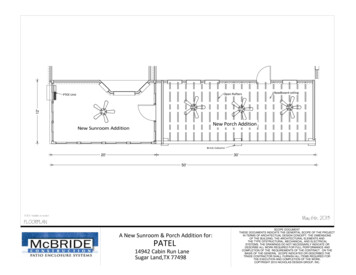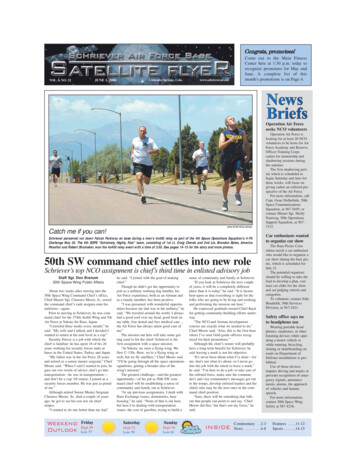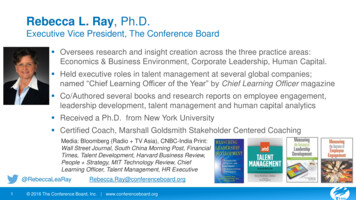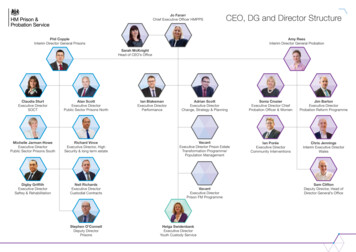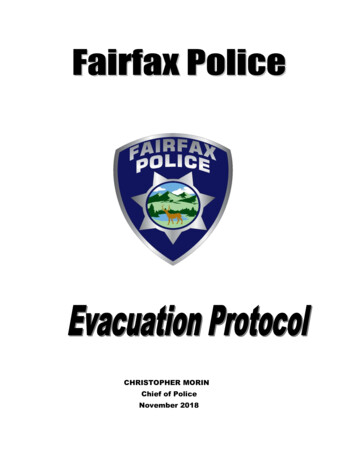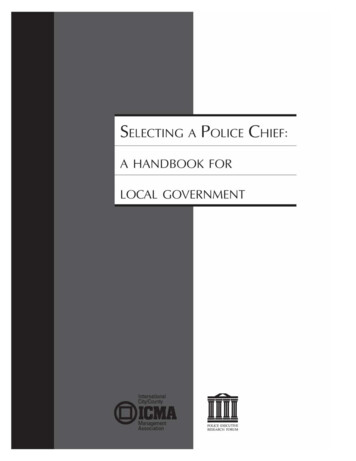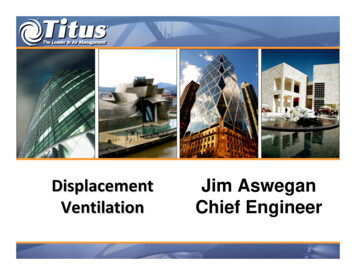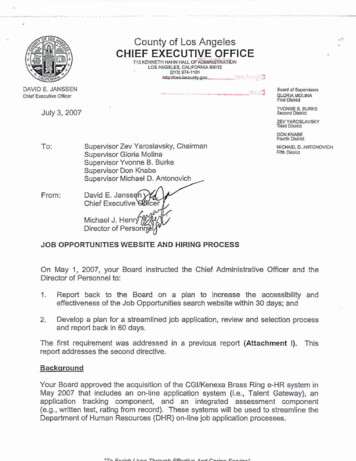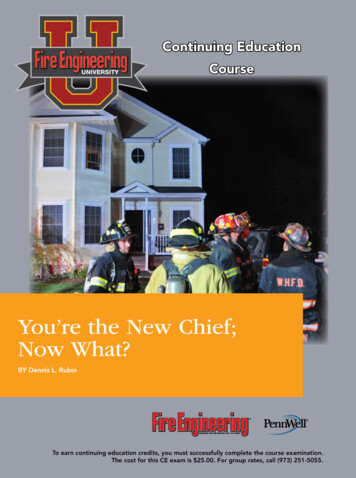
Transcription
Continuing EducationCourseYou’re the New Chief;Now What?BY Dennis L. RubinTRAINING THE FIRE SERVICE FOR 136 YEARSTo earn continuing education credits, you must successfully complete the course examination.The cost for this CE exam is 25.00. For group rates, call (973) 251-5055.
You’re the New Chief;Now What?Educational ObjectivesOn completion of this course, students will1. Learn what to do first when you finally achieve theFire Chief position2. Learn how to prioritize the steps needed to leave your markBY DENNIS L. RUBINAfter years of preparation that included extensive training, education, and experience, youhave been selected as your community’s fire department chief. The application process, consultant’s written assignments, personal interviews, jockeying for positioning, duediligence background investigations, and political wrangling areover, and the process is completed. You have been selected tobe the next person to wear all five speaking trumpets on yourcollar insignias. Tremendous congratulations are in order foryour latest accomplishment! Now it is a time to celebrate yourelevation to the corner office and finally having been selectedto serve as the top firefighter in your department. With all ofthat behind you, it would seem as if it would be time to restand enjoy what you have worked so hard to acquire. Right?As the dust settles and you move into that office you havebeen sizing up for the past 25 years, you still have a lot ofwork left to do. What should you do first? How can you prioritize the steps you will take to leave your mark on this agency?Is there a checklist or some kind of a guide for a new chief?Having been in the “new chief” role a few times, it felt as ifI were the “good ole” family dog that always chased the carsdown the driveway. Well, today is the day that Fido catchesthe Oldsmobile and wonders, “What do I do now?” That canbe a sinking feeling if the new boss doesn’t have a resourceto turn to or a mentor to talk with about the transition intothis new position.AFTER GRABBING THE BRASS RING My early days as the chief were a little scary and intimidating. There was so much to get accomplished, and everyone waslooking to me to lead the department toward my vision. Therewww.FireEngineeringUniversity.com3. Develop a transition plan4. Discover the components of meeting complianceand completenesswas not a plan, a template, a checklist, or any other guidanceavailable to reference. Flashing back, it seems like only yesterday that I received a telephone call from the mayor’s executiveassistant asking me to send over a copy of the department’s“100-Day Plan.” All I could come up with was, “What 100-DayPlan?” I am glad that I had just started my “honeymoon period”with the mayor because no one told me that she expected adetailed plan for my first 100 days in office.One of the mayor’s senior advisors came over to fire headquarters and gave me direction and instruction on what to do.Further, he provided copies of some other departments’ 100-dayplans. After I got through that process and began learning themayor’s system, the fire-rescue executive team had to developa “Turn-Around Plan” that would cover a one-year period. Themayor ran for office on a platform of reforming city government.Each department head had to develop and submit a detailedplan as to how the department would be turned around to deliver services in a more efficient and effective manner. This wasan excellent opportunity to research and build a detailed list oftasks that would have to be completed for our department to beturned around and run more efficiently. Over the past decade orso, I have made this one-year action plan more comprehensive. Iwill now share that plan with you.This information will be most useful for members whomight be asking, “What do I do now?” It is also a goodbenchmark for comparing an already developed first-yearplan of action to see if everything is included. This articlelooks at the steps I implemented to guide the department forthe first year. By the time the first year has passed, the expectation is that the chief would have developed a Five-YearComprehensive Strategic Plan to keep the agency focusedon what is important and set the direction for the future. Myadvice may not be perfect, but it has been reasonably effec-
new chiefChecklist for the New ChiefGeneral Items Learn as much as you can about your boss’s general expectations and policies. Determine the standards for the department’s performance.Budget Issues Conduct a budget review or an internal audit to determine thestatus of several mission-critical items:1. O perating budget status. Hold a review once a month atthe minimum.2. P ayroll. Other budget items should be audited on a regular or recurring basis.3. Leave and attendance records.4. Overtime and overtime controls.5. Fixed asset (capital items) inventory.6. H ire and promote to fill all funded vacancies. Ensure that the budget preparation for the upcoming fiscalyear is on track and up to date.Legal Mandates—verify the following: The written respiratory protection policy is compliant. Two-in/two-out requirements are being met. SCBA regulator and cylinder testing and certification policiesare up to date. Compressed breathing air testing and certification policy iscurrent. Annual face piece and particulate filter mask fit test is done. Compliance with the National Incident Management System(NIMS) has been adopted and is used. Annual aerial ladder testing and certification are done. Annual ground ladder testing and certification are done. HIPAA Laws are complied with. Bloodborne pathogens protection policy is in place. Bloodborne pathogens vaccinations are offered to all careerand volunteer first responder employees. Bloodborne pathogens personal protective equipment (PPE) isprovided to all career and volunteer first responder employees. Bloodborne pathogens training occurs.Communications—consider implementing the following: Weekly meetings with executive staff. Monthly meetings with senior staff. Daily operations division conference call. Weekly support services conference call. Regular “all-hands” meetings. Regular fire station visits by the chief. Monthly video program with the chief. Regular civic presentation for the community. Regular newsletter.Policies, Procedures, and Protocols—verify the following: A comprehensive review of all is conducted. Signatures are updated. Add new policies as needed. Initial policy training has taken place. Ongoing training is provided. All policies are effectively enforced.Other Surveillance Programs—verify the following: Annual hose testing. Annual pump service testing. Semiannual hydrant flush testing. Semiannual PPE inspection and cleaning. Annual third-party PPE inspection and certification. Hazard zone accountability system. Fire station smoke detector status. Fire station carbon monoxide detector status. Annual third-party fire sprinkler system testing.www.FireEngineeringUniversity.com Annual third-party kitchen hood system testing. Annual fire station fire inspection and resolution. Annual fire station “greening” audits. Ongoing fire station maintenance and repairs. General cleanliness audits.Departmental Committees—establish or reconstitutethe following: Emergency medical. Customer and community services. Community preparedness and Citizens Emergency ResponseTeams. Recruitment and selection. Technology. Apparatus specification and procurement. Hazard zone safety and accident/risk prevention. Member welfare and morale.Comprehensive training program—verify the following: EMS training. Fire training. Hazardous materials training. Rescue training. Special operations training. Administration and executive training.Support programs—verify the following: Comprehensive officer development program. Career ladder handbook. Promotional systems revisions. Recruit selection process revisions. Develop and maintain hiring list. Develop and maintain promotional lists.Accreditation and Accountability Programs—verify the following: Review ISO Officer Class. Emergency medical and ambulance license. Department accreditation status. Quarterly performance status. Alarms for service reporting. Fire loss. Various EMS efficiency reporting (i.e., cardiac survival). Response time reporting. Building inspections status. Overtime and budget status. Apparatus downtime status. Apparatus preventive maintenance status.Strategic Five-Year Planning—start this process: SWOT analysis. Part 1 – Customer and Community Services. Part 2 – Member Services. Part 3 – Apparatus and Equipment. Part 4 – Facilities. Part 5 – Technology. Part 6 – Systemic Conservation.Personal Goals and Objectives Discuss expectations of the department. Obtain state fire chief and firefighter certification. Renew all of your certifications. Update professional memberships. Consider joining local civic club. Meet with all other department heads. Meet with all mutual-aid departments. Meet with union leadership. Visit and tour all fire stations. Visit and tour all support facilities.
new chieftive in improving the operation of the organizations in whichI have worked.DEVELOPING YOUR TRANSITION PLANConsider developing a one-year written transition plan.Design the transition plan so that it clearly establishes thepriorities, direction, and vision for the fire department. Openthe plan with an acknowledgment about the capabilities, thepast efforts, and the significant accomplishments of the department. In the opening statement, respectfully acknowledgethe department’s history while preparing the agency to moveforward in a new direction. Explain that the members of thedepartment will have the opportunity to offer input and willbe empowered to help develop the overall long-term (to covera five-year period) plan as time and resources allow. Statethat the first priority of the organization will be to continue torespond to the needs of your community’s citizens and visitorsand to deliver the best public safety services attainable.A new chief has only one chance to make a good first impression. The opening statement along with the transition plan willbe the basis for a press release that informs of the department’smission, vision, and direction. It will also help people to understand more about you, the new chief. Finally, the plan can alsobe the source of a recorded message (audio or video) for department members. Everyone inside and outside your department inyour community will be looking for signs and signals that willindicate what changes will occur under the new leader. I havefound it better to make my message and intensions clear fromthe beginning. Do not let the rumor mill control the department’s direction and vision. A widely distributed transition planwill fill the informational gap and help to keep misinformationto a minimum.GOALS AND EXPECTATIONSThe first priority—after the mandatory goal to continue toanswer alarms and other related calls for help—is to learn asmuch about your boss and the direction of the “parent organization” as possible. There is no sense in developing a planthat the municipality or other final authority will not support.Next, thoroughly review the status of the current budget toensure that the department is operating within its allotted resources. Make any budgetary adjustments needed to align thebalance of the department’s spending plan with the remaining line item budget reserves. This review will ensure thatthe department has completed all of the required budgetingpreparation steps for the upcoming budget cycle as directedby the Finance Department as well.Next, the budget will have a tremendous amount of controlover where you are going and how fast you can get there.Conduct an audit review of all budgetary items including thepayroll. Schedule an audit at least every six months. Considerconducting an audit on members’ leave and attendance records. While you are at it, audit the overtime usage and reviewthe overtime controls in place to manage the overtime expenditures. Hire new members, and promote folks to fill fundedvacancies at all levels.With this “fresh” new start for the department, it would bewww.FireEngineeringUniversity.comappropriate to conduct a fixed assets (capital) inventory audit.It just makes good sense to account for everything you aregoing to be responsible for at the beginning of your watch,making sure that it exists and is in good order. At one department, the fixed asset inventory identified three abandoned firedepartment staff cars. The cars had been parked in a city parking garage and were forgotten by the department for a fewyears. Sending these vehicles to surplus made sense and wouldbe required by any good “Homeland Security” policy. Thequestion is, would these three worn-out sedans still be garagebound if we had not conducted a fixed assets inventory? The“lost vehicles” could have been embarrassing for the city, thecity manager, and me (the chief).Taking on the difficult task of learning what the “big picture” is relating to your “parent” organization’s vision and direction will go a long way to establish your credibility with thefront office (mayor, city manager, and commissioners). Havinga good understanding of the financial health of the agency onthe front end of your tenure is critical for your success. Whenstarting the accountability process, there should be a gooddeal of help available from such people as internal auditors,finance department staff, and the internal inspector’s officeand fire administration staff. If you are told that conducting athorough audit is not necessary, think twice about taking thisnew position. At a minimum, I would document this denial indetail (sounds like big trouble may be around the next bend)to protect your interest.VERIFY COMPLIANCE AND COMPLETENESSVerify that the department meets all of its legal mandates.Make sure the compliance records are being securely keptand that the records are in good order. Most likely, the local government must keep records for a required length oftime. Find this information out early, and ensure that the firedepartment is in compliance with the city’s record storagepolicy.Respiratory Protection ProgramThis is one of the first operational items you shouldconfirm and verify. The program requirements are foundin Occupational Safety and Health Administration (OSHA)29 Code of Federal Regulations (CFR) 1910.134/1910.156 andcan be found on the Web or in the OSHA Handbook. Manydetails within this law will have a direct impact on youroperation. First, find out who in your department is responsible for developing and implementing this program. Next,review every element of the program to make sure that itis being operated correctly, including documentation. Inconjunction with respiratory protection, all self-containedbreathing apparatus (SCBA) cylinders must be hydrostatically tested within the proper time frames according to theconstruction material1 used to construct the cylinders.Another element in the Respiratory Protection Program isthe two-in/two-out requirement. Review the written policythat describes how your department implemented the “Rescue the Rescuer” standard. Ensure that it contains all of themandated components described by the Code of Federal
new chiefRegulations. Review the training program for the “two-in/two-out” policy. I strongly recommend that you attend thistraining session and see firsthand that this policy and theassociated training (initial and ongoing) have been developedand implemented. By attending this training, you will befollowing two of the significant Rube’s Rules for Leadership:Leading by Example and Leading from the Front.2This same Code of Federal Regulations and National Fire Protection Association 1500, Fire Department Occupational Safetyand Health Program, describe the SCBA testing and certificationrequirements, breathing air compressor maintenance and testing, as well as SCBA breathing regulator maintenance requirements. The air a firefighter uses in an environment described asimmediately dangerous to life or health (IDLH) is regulated.The new chief (all chiefs for that matter) must make surethat the SCBA system is up to specification and certified asrequired by 29 CFR 1910.134/156. For instance, all breathingair must reach a minimum classification of Grade D. A certificate (suitable for framing or internal distribution) accompanies the tested breathing air samples that meet Grade D orbetter. I made it a practice to post all of the various requiredcertificates, annual test results, and maintenance work for allregulated items on the fire department’s Web site. The internal aspect (members-only portion) of the Web site was usedfor this purpose so that members could readily access thiscritical job safety-related information.Presidential DirectivesReview the status of your department’s compliance withthe National Incident Management System (NIMS) mandatedin Homeland Security Presidential Directive 5. The FederalEmergency Management Agency’s (FEMA) Web site providesguidance that will help your agency reach NIMS compliance. The penalty for failing to comply with the NIMS isdisqualification for consideration under all federal grants.For some departments, the grant process can add up to asignificant amount of funding. Another reason to comply isto avoid embarrassment and confusion if the department iscalled out on mutual aid or operates with another outfit thatis “NIMS fluent.”Homeland Security Presidential Order 12, which coverspersonal identification cards for first responders, will alsoimpact your department. This order, of course, affects therequired identification card system first response agencies use to enter federal property. Since every communityhas federal buildings and this order is an effective way toidentify first responders, it helps to protect our homeland.Make sure that your department is in compliance with bothof these Presidential Orders; they have a direct impact onthe first responder community.More Testing and CertificationsEvery aerial ladder and ground (portable) ladder should betested annually and certified by an independent third partylicensed to perform this service. The third-party outfit is toinspect aerial ladder trucks from bumper to bumper on anannual basis. Because ladders of all types are so closely tiedwww.FireEngineeringUniversity.comin with life safety and OSHA has been known to fine departments that have failed to test and certify their ladders, Iplaced this process on the mandatory list. It could be debatedthat this testing is not a requirement but only a recommendation for departments that do not use their ladders. I hope thatthis sentence sounds as ridiculous to read as it was to write.Approach this requirement as if all aerial and ground ladders are to be tested in a one-month time frame (if possible).Allow a window of two or three months (before the certification is due) to make needed repairs to aerial ladder trucksand ground ladders. When the vehicles or portable laddersare tested, the agency conducting the certification inspectionwill provide a list of needed repairs that the department mustcomplete before certification can be obtained. The repairs arelisted according to their significance for affecting the functionality of the vehicle or ladder. The worst of the deficiencies will require that the vehicle or ladder be placed out ofservice immediately, since it is in imminent danger of failingand will likely cause injury. The least deficiency is describedas minor repairs or adjustments; the vehicle or ladder canremain in use. However, these repairs must be made beforethe outside agency can grant annual certification.Remember to include the reserve apparatus in the testing.This will cause some scheduling issues that could c
AFTER GRABBING THE BRASS RING My early days as the chief were a little scary and intimidat - ing. there was so much to get accomplished, and everyone was looking to me to lead the department toward my vision. t here was not a plan, a template, a checklist, or any other guidance available
